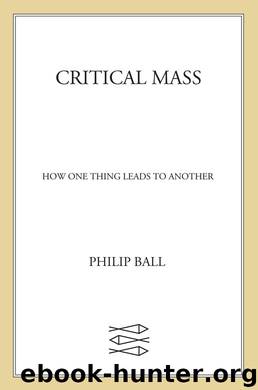Critical Mass by Philip Ball

Author:Philip Ball
Language: eng
Format: epub
Publisher: Farrar, Straus and Giroux
Published: 2012-05-16T04:00:00+00:00
11.5 The simulated firms have a typical history: exponential growth followed by sudden decline and gradual dwindling. Here is one example.
If we believe that such a simplified model can tell us anything at all about the real world, then we learn some revealing things about firms. First, they are not maximizers. Finns as a whole maximize neither profit nor overall utility (as conventional theories would have us believe). Individual agents do try to maximize their utility, but this does not induce such behavior in the group as a whole.
The firms that do best are not those that aim to make the most profit. Rather, longevity in a company stems from being able to attract and retain productive workers. A firm fails not when its profit margins are eroded but when it is infiltrated by slackers.
The notion that putting profits first does not make a firm successful should not come as a surprise to those in the business community, although they have sometimes been reluctant to acknowledge it. Some market fundamentalists regard profit maximization not just as a principle of sound management but as a social obligation: it is the notorious “greed is good” paradigm. But as the British economist John Kay points out, it simply doesn’t work. If the employees suffer from the profit motive, so does the firm: “The piece-rate systems of car factories were abandoned because they destroyed social relationships in the workplace, provoked endless negotiation and confrontation, and established a working environment in which no one cared about the quality of the product.”9
Axtell’s model does not allow for these complexities of worker interactions; but to the extent that it does imbue its agents with a kind of free will (how hard to work, whether to stay or quit), this worker choice comes immediately into play to determine the company’s success or failure.
Axtell feels that traditional microeconomic theories of the firm have found themselves in a blind alley because of their neglect of this dynamic, ever-changing face of the labor market. The tendency, he says, has been to develop models that assume uniform intentions on the part of workers, and then to look for stable, equilibrium configurations in which each of them is happily in one firm or another. These theories, says Axtell,
Download
This site does not store any files on its server. We only index and link to content provided by other sites. Please contact the content providers to delete copyright contents if any and email us, we'll remove relevant links or contents immediately.
| Anthropology | Archaeology |
| Philosophy | Politics & Government |
| Social Sciences | Sociology |
| Women's Studies |
Nudge - Improving Decisions about Health, Wealth, and Happiness by Thaler Sunstein(7615)
iGen by Jean M. Twenge(5366)
The Fire Next Time by James Baldwin(5249)
Adulting by Kelly Williams Brown(4487)
The Hacking of the American Mind by Robert H. Lustig(4318)
The Sports Rules Book by Human Kinetics(4294)
The Ethical Slut by Janet W. Hardy(4173)
Captivate by Vanessa Van Edwards(3795)
Mummy Knew by Lisa James(3632)
In a Sunburned Country by Bill Bryson(3481)
The Worm at the Core by Sheldon Solomon(3435)
Ants Among Elephants by Sujatha Gidla(3417)
The 48 laws of power by Robert Greene & Joost Elffers(3024)
Suicide: A Study in Sociology by Emile Durkheim(2972)
The Slow Fix: Solve Problems, Work Smarter, and Live Better In a World Addicted to Speed by Carl Honore(2947)
Humans of New York by Brandon Stanton(2835)
The Tipping Point by Malcolm Gladwell(2827)
Handbook of Forensic Sociology and Psychology by Stephen J. Morewitz & Mark L. Goldstein(2658)
The Happy Hooker by Xaviera Hollander(2654)
